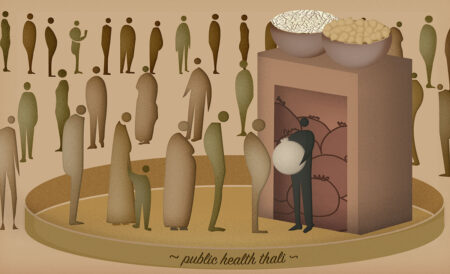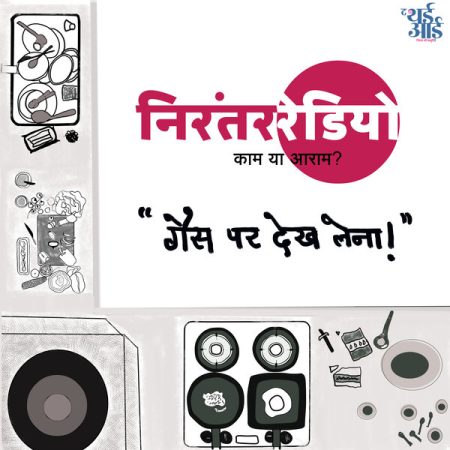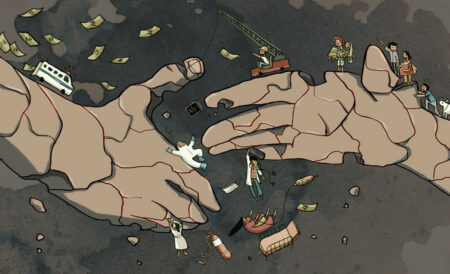As part of The Third Eye’s Public Health edition, we spoke with a wide spectrum of experts, community leaders and practitioners — what works, why it does, and what an equitable public health system could look like.
Reetika Khera is a development economist who has consistently advocated for improved welfare provisioning in the country, with her research focussing on the public distribution system (PDS), food security, and the impact of Aadhaar on welfare. Khera is currently Associate Professor in Economics at the Indian Institute of Technology, Delhi. Since her scholarship over the last decade has sought to inform what governance “ought to be”, The Third Eye asks her what models of equitable healthcare in India can look like.
This interview took place in May 2021 and this is an edited transcript of the conversation.
We are trying to understand public health as an idea. From a theory perspective in economics, what is that idea?
My own understanding of health issues comes from having been trained in economics. In economics itself, the pioneering work in 1963 was by Kenneth Arrow, who won the Nobel Prize (jointly with John Hicks in 1972). He opened up many fields of study within economics, including health, with a very good paper where he explained how, in the field of health, it doesn’t make sense to leave things to the market because uncertainties and asymmetric information lead to market failures.
And I think that's where economics and public health perspectives come together. Leaving healthcare to the market alone is not going to be, as the economists like to say, efficient. And it is even less likely to be equitable.
With economics, too often, the equity aspect comes as an afterthought, because that’s how the field evolved. Welfare, development and wellbeing became legitimate things for us to study late in the evolution of the discipline. A reason why Arrow and others have always felt that health is not a good area to leave to the market is because of what we call “externalities”—basically that my behaviour doesn’t affect me alone but also affects you—sometimes positively, and sometimes negatively. And because of that, the conditions that lead to efficient outcomes through the market mechanism break down.
Another aspect of market failure in health is coordination and economies of scale. Take our sanitation policies. The public health benefits of building toilets will only come if you also find ways of getting rid of the sewage in a hygienic manner. This is the kind of thing where you need a lot of coordination, especially in densely populated areas.
I think toilets are closer to private goods and therefore could have been built with people's own money, and the government effort and money could have been focused on providing the sewage and treatment infrastructure, which is much more of a public good.
Which other public health models, globally, do you feel we can learn from?
I have experience with three—the Indian one, the NHS in England, and the American one from when I was a postdoc scholar there. The NHS in the UK involves direct government provisioning. As a student, I could just walk into the health centre, and I would be entitled to any diagnostic test, any kind of medicine, any kind of consultation with either a GP or a specialist and all of that would be paid with people’s taxes.
The American system shares many features with the Indian one, wherein the system is fragmented: government involvement in running of hospitals or paying doctors, diagnostics and medication etc., is small. In the US, for-profit, private health insurance is big. Insurance is mostly through your employer, leaving many without health insurance. (This has changed a bit since Obamacare.)
The Indian system, however, involves huge out-of-pocket expenditure—World Bank data from 2018 shows that around 60% of total health expenditure that people incur is from their pockets. In the same year (2018), however, in the US that figure was only 10%. Of course, they do have to pay health insurance premiums.
There is another system in Japan and Germany. It is like social insurance where services are not directly provided by the state. Most doctors in Japan and Germany are private doctors, but the cost of the insurance is shared by the government, the employer, and the person themselves. The most important thing is that these health insurance funds are not allowed to make a profit. There is private provisioning, but very heavy state regulation. To the extent that every year, the government negotiates the price for all possible services with the insurance fund and/or doctors’ association. The price regulation is down to saying that if I have a one-inch cut on my hand, and I need six stitches, then what is the price going to be? Everyone has to stick to these rules if they want to make money. If they don’t agree to it, then they can’t be providing these services.
One reason this works in those countries is that the employers are obliged by law to pay a part of the premium, and the state pays for those people who are out of employment. In India, one [problem] would be the high unemployment rate. Moreover, how is the government, which has no spine at all, ever going to compel employers to share these costs? It will require a significant shake-up in the way we think about these things politically as well as economically.
Do you feel that of the three, the Japan/Germany model could make sense for India?
I would hesitate to say which one. Look, there’s a very big presence of the private sector in India already. Even when the NHS was brought about in the UK, it was not easy for [UK Minister of Health Aneurin] Bevan to negotiate with the doctors to become government employees. Our problem is going to be more magnified because market interests are even more deeply entrenched here. I believe many states rejected the private health insurance model that was being pushed through Ayushman Bharat, in favour of something that resembles social insurance. Here are some tentative thoughts:
One is that the government’s focus on direct provisioning will bolster preventive healthcare and primary healthcare services so that minor ailments don’t escalate and become big medical expenses. Two, the government should regulate the private sector. You can’t have one hospital charging you Rs.3,000 or Rs.4,000 and another charging you Rs.20,000. That just has to stop. During the pandemic, one kind of regulation that some state governments tried was to requisition beds from the private sector. With a combination of such measures, exploitative profiteering by the private sector can be controlled.
The problem is also that the moment you talk about such government intervention, people say “communist hell, socialist hell”, but actually these are well-established, widely-used practices in capitalist countries. We have just not heard enough about them.
Because insurance companies [in these systems] are assured of volumes, they can survive on smaller margins. But that requires the government to be firm and to stand up to them.
Talking of regulation, last year in Rajasthan the government tried regulating the prices of Covid lab tests, but the private labs stopped testing after a point because it was no longer profitable for them. How do we counter something like that?
In countries like Japan, not following the law is not an option for private providers. Regulation is only one part of the problem. You have to also control the fact that they make you overspend. If I go to a doctor, (s)he knows whether I need a simple X-ray or whether I need a CT scan. But (s)he also knows that this patient will do whatever I tell her to because she doesn’t know better and she’s concerned about her health. This is what we call asymmetric information. When profit enters the equation, that trust is obviously going to suffer, right? There’s this coming together of corporate interest and state interest. We would need greater attention to professional ethics and concerted public action to sort this out.
If we were to take a step-wise approach to such a movement, what would be the first things to do to build equity?
I think Tamil Nadu and Himachal Pradesh are states to learn things from, especially in primary healthcare. I have been to rural Tamil Nadu, where you will have a functional primary health centre (PHC) with nurses, at least one doctor, an ambulance driver, and there would be living quarters for the staff. These little details have made the whole system come together. They seem to have worked hard on it. In Himachal Pradesh, I found even sub-centres (operating at the gram panchayat level) open. You need a very robust first line of defence, i.e., primary healthcare. Even in the NHS, that first point of contact is the nurse. Whether it’s diarrhoea, fever, cold, cough, or just regular monitoring of your BP, etc., you don’t need to see your doctor straightaway. Trained nurses can actually deal with a lot of those things and that’s one way of containing costs as well.
Instead, what India has been doing so far, (say, through Ayushman Bharat or Rashtriya Swasthya Bima Yojana (RSBY), is to focus on tertiary care. So what you're telling the patient is that even though you have a wound right now, the government won’t pay to heal it, but if it becomes gangrenous and your limb needs to be amputated, then the government will step in and pay. It's such a foolish way of doing things.
The healthcare outcome is worse—I lose my hand, and it is expensive for the government because they end up paying for an avoidable and expensive procedure. Focusing on primary healthcare then is a stitch-in time-saves-nine kind of logic. So, a short-term health strategy could be a combination of robust primary healthcare and strict regulation of the private sector so that catastrophic health expenses can be contained.
You have talked about the Tamil Nadu model, which very interestingly, many people don’t. Any other states that have stood out for their health outcomes?
Some initial first steps have been taken in a bunch of states—Chhattisgarh, for instance, invested heavily in the ASHAs—the Mitanins—and then that became a national model. Another thing that Chhattisgarh did first, or maybe Tamil Nadu before that, was to have a whole list of generic medicines and diagnostic tests, about 30–35 of them, that would be administered for free at the PHC or Community Health Centre (CHC) level.
However, while it's true that you could rely more on trained nurses so as to contain costs, you must pay them a salary that counts as a salary. In some states, ASHAs/Mitanins get paid Rs.2,000. They're treated like ‘volunteers’.
There are many crucial aspects of the health system that don’t see the light of day in mainstream news. Even now, the coverage of the Covid crisis focuses overwhelmingly on infrastructure—lack of beds, lack of oxygen cylinders, lack of ventilators—and the question of well-being is not a priority.
I’m heavily influenced in my thinking about this from reading The Five Giants: A Biography of a Welfare State, by Nicholas Timmins, which is about the big five things that England did post-World War II. For the first time, well-off British people saw and were moved by how the others in their own country were living. Moreover, the bombs did not distinguish between rich and poor. Last year, when the migrants were moving back to their hometowns, I optimistically wondered if this could be India’s Beveridge Report [the 1942 government report that led to the creation of the UK welfare state] moment.

The conversation should not just be about well-being, but also about dignity. For example, with the vaccination programme, the impression on everyone’s mind is that you have to book a slot, but the official policy says that the 18–44 age group can walk in and get vaccinated if there is an open vial for which there is no booking. So basically, they want those who cannot book slots through smartphones to stand in queues waiting for their turn for leftovers. It is really offensive. Nobody is talking about dignity.
Instead, if they had a proper walk-in policy, then the probability of me getting vaccinated would have been the same as that of a mazdoor getting vaccinated because we would all stand in the same queue. (This assumes that vaccination centres are geography-neutral.) The minute you make it through CoWIN, immediately you’ve pushed poorer citizens thousands of paces behind in the line.
All in all, the state’s response to the Covid crisis has been overwhelmingly digital and data-driven—whether it is Aarogya Setu for contact tracing, or information on symptoms, or self-monitoring or CoWIN for registration for vaccines—with an argument being made each time for efficiency. Do you think all of this could have been done outside this digital architecture? What could that have looked like?
When the government is saying that it is efficient, it is communicating to the top 20% of the population. It is not even bothering to communicate to the remaining 80%.
Last year, when the lockdown happened, [Union Minister Prakash] Javadekar said that since people are going to be confined to their homes for three weeks, we will telecast Ramayana and Mahabharata once again. Who was he talking to? Who can afford to watch Ramayana in the Indian population when there is no earning coming into the house?
Much more could have been done the old-fashioned way. Setting up camps in different parts of the city would have reduced queuing also, something that has definitely not been solved by CoWIN. To avoid crowded vaccination centres, we do have gram panchayats and schools everywhere. Schools are being used in Delhi. In rural Chhattisgarh, there are similar efforts.
TTE: You know how everyone says ki gaon mein log rumours believe karte hain, log vaccine nahi lete hain, etc. … underneath all that there is actually a complete trust deficit with the state. This is something we have been noticing in Uttar Pradesh, Rajasthan, and Jharkhand. We have multiple accounts of people saying that mar jayenge lekin hospital nahi jayenge, mar jayenge lekin vaccine nahi lenge. From our reading, it is a long-term result of the state according no dignity to the poor.
Vaccine hesitancy in rural areas is getting very little attention. When we go and talk to them, they’ll tell us all about it. But otherwise, they are certainly not heard. In Indian democracy, there is a certain class that matters and a lot of the policy design and implementation is geared to satisfying that top 5-10%, or maybe 15-20%. That might be why public education and awareness to reduce vaccine hesitancy has not got much attention.
Can addressing the asymmetry in information be one of the first steps towards equity?
Absolutely. That is such an important pillar of the NHS too. Preventive healthcare is an inexpensive way of keeping your population healthy and one important part of it is education—nutrition and health education. Like even as far as Covid-19 is concerned, we have this amazing network of ration shops and the government could have distributed masks to everyone [through these]. People would not have had to spend on masks and everyone would’ve received masks by now. If they had got the masks, they would’ve known that this is a serious matter, not to be taken lightly.
What role can citizens play in this? For example, in several rural locations around the country, people have actually been speaking up against city dwellers turning up at rural vaccination centres to avail slots. So it’s not a totally hopeless situation, right?
Not at all. I am glad about the reporting, say, in The Hindu and The Indian Express on the access issue for poorer people in cities or people in rural areas. Greater awareness and visibility of the issue will help the techies, who are using code to grab all vaccine slots, understand that they’re being selfish. Not everyone will change their behaviour, of course; but hopefully, they’ll understand that even if they vaccinate themselves, they can only be safe when we reach 50% to 80% vaccination rates.
George Orwell has this line, “Either we all live in a decent world, or nobody does.” The World Health Organisation (WHO) in the context of this vaccine is saying something similar—nobody’s safe until everybody’s safe—because you do need to get the vaccination rates up to a very high level before it is effective against the virus. Therefore, the government needs to step in. Last year, when the media reported on this massive scale about the migrant workers and urban workers who were trying to get home, the government did act, right? So I feel if there is enough pressure, then the government will hopefully try to fix its policies, whether it’s in terms of vaccine procurement, or production, or pricing, or equitable distribution. [Indeed, a few weeks after this conversation was recorded, there has been some change in the right direction.] So we have to speak up and use our voice in whatever way we can, including social media since they’re so sensitive to social media.
I think one reason we’re not able to build consensus for these issues and citizen interventions is because the rich Indians think they're middle class when they're actually the top 1%. So this perception needs to change. The ones who have a voice in the Indian democratic system need to understand exactly where they sit [on the income distribution] and also be confronted with the reality of the remaining 99%.
There seem to be two kinds of arguments—one is for kindness and empathy where we hope that people are going to realise they shouldn’t be selfish, and the other is the efficiency argument where you realise that if someone else doesn’t get the vaccine, then it won’t make sense for you.
Both are valid concerns, right?
Are you saying there’s self-interest in solidarity too?
I’m just saying that to build a decent society, we all need to be decent. I think that’s what Orwell also meant when he said, either we all live in a decent world, or nobody does.





